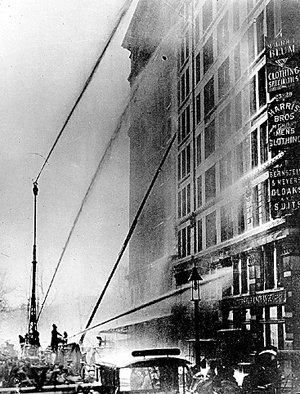The Triangle Shirtwaist Factory Fire: March 25, 1911
As a continuation of our series of posts on National Women’s History Month, today’s post will be about an event from 99 years ago today–the Triangle Shirtwaist Factory fire in New York City.
While horrific–146 workers, mostly poor Italian, German, and Jewish women between the ages of eight and twenty perished–the fire at Triangle Shirtwaist holds an important place in the fight for gender equality and in labor history.
 Even before the famous fire, the Triangle Shirtwaist Factory played a notable part in helping improve conditions for female workers. A 1909 labor strike, initiated by a walkout at Triangle Shirtwaist Factory, became the largest strike by American women at the time, earning the name “The Uprising of the Thirty Thousand.” The impressive half-year strike led to arbitration between the labor organizations and the corporations, but results were mixed: while immigrant labor issues were given a greater spotlight than before, workers were not consulted during the process, and safety concerns were ignored.
Even before the famous fire, the Triangle Shirtwaist Factory played a notable part in helping improve conditions for female workers. A 1909 labor strike, initiated by a walkout at Triangle Shirtwaist Factory, became the largest strike by American women at the time, earning the name “The Uprising of the Thirty Thousand.” The impressive half-year strike led to arbitration between the labor organizations and the corporations, but results were mixed: while immigrant labor issues were given a greater spotlight than before, workers were not consulted during the process, and safety concerns were ignored.

The fire that spread just before closing that day, killing 146 who either burned in the building or jumped from the top floors of the twelve-story building to escape the flames, changed the face of women’s labor history forever. No longer would it be permissible to have only one fire escape, a broken one at that, for an entire factory. No longer would inspectors turn a blind eye when laborers worked in rat-infested dumps that would be deemed unfit for livestock. Business owners would no longer be able to ignore governmental hazard warnings, as Triangle Shirtwaist had done two years earlier. In the wake of the Triangle Shirtwaist Factory fire, the public, especially the immigrant communities who lost loved ones in the blaze, became active in the labor fight, joining groups like the International Ladies Garment Workers’ Union, making it one of the most important unions in the United States.
 For those interested in the Triangle Shirtwaist Factory fire and how it changed labor history for women, UNC Press has two phenomenal books on the subject. Published this spring, Jennifer Guglielmo’s Living the Revolution: Italian Women’s Resistance and Radicalism in New York City, 1880-1945 is a much needed investigation of how two generations of Italian immigrants brought progressive politics into the needle and textile trades, mixing forms of protest from their homeland with the vast urban networks of New York City.
For those interested in the Triangle Shirtwaist Factory fire and how it changed labor history for women, UNC Press has two phenomenal books on the subject. Published this spring, Jennifer Guglielmo’s Living the Revolution: Italian Women’s Resistance and Radicalism in New York City, 1880-1945 is a much needed investigation of how two generations of Italian immigrants brought progressive politics into the needle and textile trades, mixing forms of protest from their homeland with the vast urban networks of New York City.
An older but equally engaging book that deals with the Triangle Shirtwaist fire and the labor movement is Annelise Orleck’s Common Sense and a Little Fire: Women and Working-Class Politics in the United States, 1900-1965. Orleck artfully uncovers the personal and private lives of four immigrant women who worked at Triangle Shirtwaist Factory and went on to be leading activists in the labor world.
Make sure to check back with the blog in the next week–we’ll have one more post on National Women’s History Month and new titles from UNC Press.
– Matt
